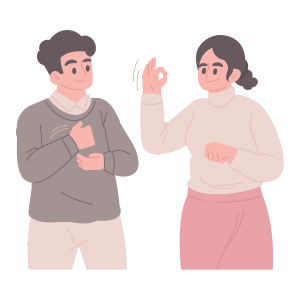Introduction: When Stress Takes a Physical Stage
Imagine Claire, an accomplished pianist, whose fingers have danced over keys since she was a child, creating melodies that sang of her life’s joys and struggles. Yet, as the date of her grandest concert approached, a paralyzing stiffness seized her hands. Medical tests showed no physical ailment.
Claire’s condition was a vivid manifestation of ‘Conversion,’ a psychological defense mechanism where emotional turmoil transforms into a physical symptom.
This mysterious alignment of mind and body presents a compelling entry point into our exploration of Conversion. Could Claire’s silent stresses be echoing through her very sinews and muscles?
Understanding the Defense Mechanism of Conversion

Definition
Conversion is a psychological defense mechanism where emotional or psychological stress is subconsciously channeled into a physical symptom. This phenomenon reflects the power of the mind over the body, where mental tensions materialize as tangible medical concerns that often defy organic diagnosis.
Mechanism
The process of Conversion typically springs from unresolved conflicts or distress within an individual’s psyche. When emotions become too overwhelming to process or express, the unconscious mind converts these fraught feelings into physical manifestations. It’s as if the body speaks what the mind cannot articulate, ensuring the individual’s deeper anxieties are communicated through a different language altogether.
Examples
- A soldier might experience unexplained loss of sensation in their legs after witnessing the traumas of combat, despite no physiological damage.
- A person feeling trapped in an oppressive situation may suddenly lose their voice, symbolizing their stifled ability to speak out.
- Students under immense academic pressure may develop inexplicable headaches or nausea during examination periods, without any underlying medical cause.
Theoretical Perspective
The Defense Mechanism of Conversion finds its roots in early psychoanalytic thought, most notably in the work of Sigmund Freud. Freud initially studied ‘hysteria,’ a condition where individuals displayed physical symptoms without a physical cause, and later theorized these as manifestations of psychological conflict. The term conversion was adopted to describe the process by which psychological stress is ‘converted’ into a physical symptom.
Types of Conversion
- Motor Conversion: Manifests as disturbances in voluntary motor or sensory functions. Examples include paralysis, tremors, gait problems, or even pseudo-seizures.
- Sensory Conversion: Includes sensory symptoms such as numbness, blindness, or deafness, for which no medical explanation can be found.
- Pseudo-Neurological Conversion: Encompasses symptoms that mimic neurological diseases such as coordination problems or localized weakness but are rooted in psychological factors.
Defense Mechanism of Conversion and Related Concepts
- Somatization: A broader concept where individuals experience and communicate psychological distress through physical symptoms, often involving multiple bodily systems.
- Dissociation: While distinct from conversion, dissociation also involves a disconnection – in this case, between an individual’s thoughts, memory, and sense of identity, which can sometimes have physical manifestations.
Understanding conversion’s place in the landscape of defense mechanisms provides valuable context for recognizing and addressing this complex response to psychological stress.
The Impact of Conversion

The impact of conversion extends far beyond its immediate physical manifestations, influencing various aspects of an individual’s life and well-being.
How Conversion Can Be Helpful
- Emotional Relief: By converting psychological distress into a physical symptom, individuals may experience temporary relief from intense emotional turmoil.
- Communication: Physical symptoms can serve as a non-verbal way to communicate emotional pain when words are insufficient or when expressing emotions is not permitted or possible.
- Avoidance: Conversion can allow individuals to avoid confronting or dealing with the source of psychological conflict, providing an escape from distressing thoughts or situations.
Problems Conversion Can Create
- Medical Confusion: Unexplained physical symptoms often lead to extensive medical evaluations, which can be costly, time-consuming, and stressful.
- Relationship Strain: Family, friends, and healthcare providers might struggle to understand and support someone with conversion symptoms, leading to frustration and isolation.
- Limitations: Physical symptoms from conversion can limit functioning and quality of life, hindering an individual’s ability to work, engage in social activities, or perform daily tasks.
Examples in Different Areas
- Personal: An individual with unresolved guilt might develop stomach pain that represents the ‘knot’ of unresolved feelings but limits their social engagement.
- Professional: Workplace stress or conflict can lead to symptoms like a pseudo-neurological limp, becoming a visible sign of distress and impacting job performance.
- Academic: A student with test anxiety could experience a conversion symptom like blurred vision, creating challenges in completing exams and progressing educationally.
Conversion in Therapy: A Therapist’s Perspective

In therapeutic settings, Defense Mechanism of conversion presents unique challenges, as clients often arrive with symptoms that straddle the domains of physical health and psychological well-being.
Client Challenges
Clients grappling with conversion typically come seeking answers for physical symptoms that have eluded medical explanation. They may feel frustration and confusion about their unexplained ailments.
For example, a client may be dealing with recurring migraines that intensify during periods of emotional stress, leading them to seek help despite extensive medical tests revealing no clear cause.
Navigating Conversion in Therapy
The therapeutic goal is to help clients uncover the emotional root of their physical symptoms. Therapists create a safe and validating environment for clients to explore feelings that may be difficult to acknowledge or express. Delving into the client’s history, therapists can often trace the symptom back to emotional triggers or past traumas.
Indirect Approach to Addressing Conversion
Rather than confronting the defense mechanism head-on, therapists might facilitate the client’s awareness of the mind-body connection through gentle exploration. Discussing the concept of conversion indirectly can prevent clients from feeling accused or defensive, which is crucial for building trust and openness in the therapeutic process.
The journey through therapy can be crucial in helping clients recognize their conversion symptoms as a non-verbal language of deeper emotional states.
Overcoming Conversion with Cognitive Hypnotic Psychotherapy: A Guide for Therapists
Cognitive Hypnotic Psychotherapy (CHP) is a valuable therapeutic approach for addressing and resolving the complex phenomenon of conversion. By utilizing CHP, therapists can facilitate clients’ journey toward uncovering the emotional underpinnings of their physical symptoms.
This approach enables therapists to engage with both the conscious and unconscious aspects of the client’s mind, fostering deep exploration and profound healing.
Techniques for Addressing Conversion in CHP
- Delayering Processes: Techniques like Corrective Therapy, Self Validation and Integration Therapy, Void Identification and N-Step reframing allow therapists to help clients peel away the layers of psychological defenses to reach the core emotional experiences that manifest as physical symptoms.
- Somatic Bridging: Utilizing the client’s physical symptoms as entry points to access repressed emotions and traumas that contribute to their condition.
- Hypnoanalysis: A form of hypnotherapy that combines psychoanalysis with hypnosis to explore the client’s subconscious mind and draw connections between their mental and physical states.
- Narrative Re-authoring: Helping clients rewrite their personal narratives to reconstruct a sense of self that acknowledges and integrates their emotional and physical experiences.
- Interoceptive Exposure: Guiding clients to mindfully confront and desensitize themselves from the physical discomfort associated with their symptoms, reducing the need for psychological conversion.
Through the application of these CHP techniques, therapists assist clients in transforming their understanding of and relationship with their symptoms. The goal is to promote recognition of the emotional conflicts expressed through conversion and to support clients in finding healthier ways to cope with and express their underlying emotional needs.
Conclusion: Integrating Mind and Body Towards Healing
As we conclude our exploration of the defense mechanism of conversion, we embrace a holistic understanding of how intertwined our minds and bodies truly are. Conversion symbolizes the profound impact that unresolved emotional conflicts can have on our physical selves, and it’s a reminder that our bodies often speak when our words cannot find their way.
Through Cognitive Hypnotic Psychotherapy, therapists offer a compassionate and effective path that helps clients navigate the complexities of conversion. The therapy facilitates an environment where clients can safely address the psychological sources of their distress, transforming physical symptoms into words and insights that foster true healing.
The therapeutic process is not about eliminating a symptom but rather about understanding its message. It’s about empowering clients to reconcile the split between their emotions and physical experiences, paving the way toward a more integrated and fulfilling life.

